Mutagenesis Services
Creative BioMart offers precision-engineered Mutagenesis Services tailored for genetic research and protein engineering. With our GenePower™ technology and expert team, we deliver rapid, reliable results—even for complex and high-demand projects. Whether you're investigating gene function or engineering proteins with enhanced or novel traits, our services provide unmatched flexibility, high accuracy, and ultra-fast turnaround times. We go beyond mutagenesis, offering complete support from template preparation to protein expression, helping you focus on discovery while we handle the heavy lifting.
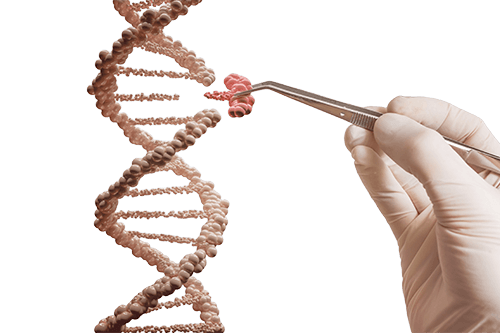
Background: The Power of In Vitro Mutagenesis in Genetic and Protein Research
In vitro mutagenesis is a cornerstone technique in molecular biology, enabling precise modifications to DNA sequences to understand gene and protein function, or to create variants with desirable characteristics. Whether you're introducing single-nucleotide polymorphisms, deleting functional domains, or inserting new elements, mutagenesis serves as a powerful strategy in both basic and applied biological sciences.
Random Mutagenesis
- Chemical Mutagenesis : Chemical agents such as ethyl methanesulfonate (EMS) or nitrosoguanidine (NTG) are used to introduce random mutations into DNA. These chemicals can cause point mutations, insertions, or deletions.
- Physical Mutagenesis : Ionizing radiation (e.g., UV light, X-rays) can also be used to induce random mutations. UV light, for example, can cause thymine dimers, leading to errors during DNA replication.
Directed Mutagenesis
- Site-Directed Mutagenesis : This technique involves the introduction of specific mutations at precise locations within a gene. It is often used to study the effects of specific amino acid changes on protein function. Techniques such as polymerase chain reaction (PCR)-based mutagenesis are commonly used.
- Oligonucleotide-Directed Mutagenesis : This method uses short DNA oligonucleotides containing the desired mutation to introduce changes into a target gene. The oligonucleotides are hybridized to the target DNA, and the mutations are incorporated during DNA replication.
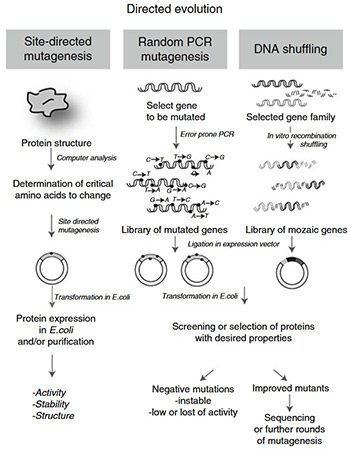
Figure 1. Schematic representation of three major strategies to follow for protein mutagenesis: site-directed mutagenesis, random PCR mutagenesis and DNA shuffling. (Vogne et al ., 2010)
Applications of Mutagenesis Services
- Functional Genomics : dissect gene roles by introducing specific mutations.
- Disease Modeling : mimic pathogenic mutations for mechanistic studies.
- Protein Engineering : generate variants for improved activity, stability, or novel functions.
- Therapeutic Discovery : design mutant proteins for drug development or targeted therapies.
Overview of Our Mutagenesis Service
Service Procedure
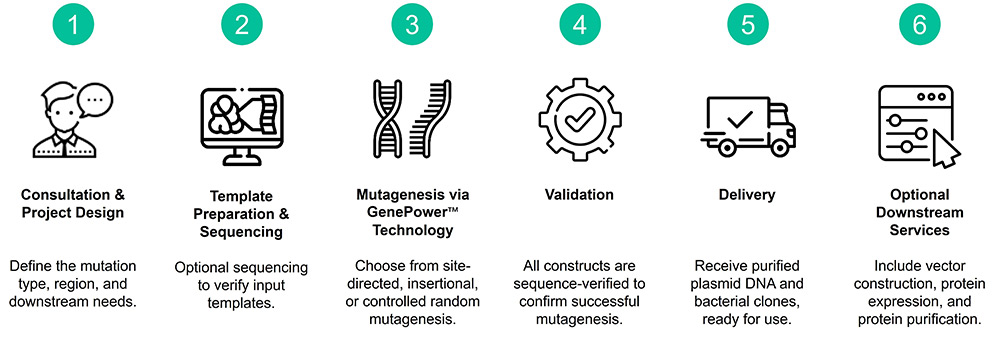
Service Offerings: Tailored Mutagenesis Options
-
Using our GenePower™ Site-Directed Mutagenesis, we introduce precise mutations—substitutions, insertions, deletions, or truncations—into your gene of interest. Whether it's a single mutation or multiple, we ensure high-fidelity edits without compromising the rest of the sequence.
-
Insertional Mutagenesis
Ideal for functional genomics and oncology research, our Insertional Mutagenesis platform allows for high-throughput gene discovery. It’s particularly powerful in forward genetic screens to uncover novel cancer-associated genes.
-
Our GenePower™ Controlled Randomization service offers an advanced alternative to error-prone PCR. You choose the target region and mutation frequency, and we deliver a library of diverse variants—perfect for protein evolution or structure-function studies.
Advantages of Our Mutagenesis Service
- Rapid Delivery of Validated Constructs : Our streamlined mutagenesis workflow ensures prompt delivery of fully verified plasmids
- High Accuracy : All mutations are confirmed by DNA sequencing. We guarantee precise edits—no unwanted changes.
- Unlimited Sites, Unlimited Potential : Introduce multiple mutations in a single project with no restrictions on mutation sites.
- GenePower™ Technology : Our proprietary system provides cost-effective, scalable, and customizable mutagenesis options.
- One-Stop Solution : From DNA to purified protein, we support the entire workflow under one roof.
- Expertise You Can Trust : Backed by years of experience and a proven track record across academia and biotech.
Case Studies on Site-Directed and Random Mutagenesis
* NOTE: We prioritize confidentiality to safeguard our clients’ technology and intellectual property. As an alternative, we present selected published research articles as representative case studies. For details on the assay services and products used in these studies, please refer to the relevant sections of the cited literature.
Case 1: Structure – function insights into plant OSCs through mutagenesis
Chen et al. , 2021. doi:10.1039/D1NP00015B
Oxidosqualene cyclases (OSCs) catalyze complex polycyclization of 2,3-oxidosqualene to produce diverse triterpene structures in plants. Despite this product diversity, plant OSCs exhibit highly conserved protein sequences, with a few critical amino acids influencing product specificity. In the absence of crystal structures, researchers rely on site-directed mutagenesis and substrate modifications to study their mechanisms. This study compiles 98 mutation sites across 25 plant OSCs, identifies key conserved residues through sequence alignment, and discusses structure–function relationships and substrate selectivity to better understand the OSC active site.
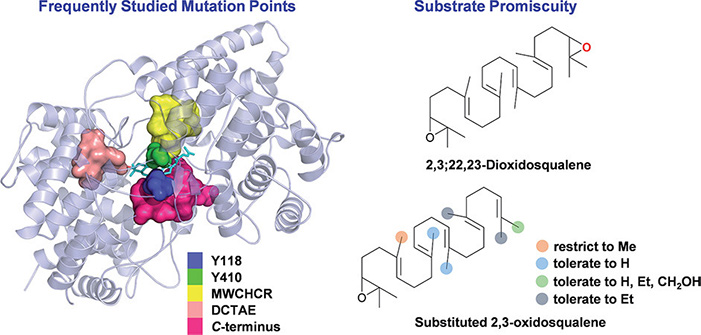
Figure 2. Site-directed mutagenesis and substrate promiscuity of plant OSCs were summarized to understand the cyclization mechanism. (Chen et al ., 2021)
Case 2: Genetic and mutagenic strategies to improve RSDE in Penicillium oxalicum
Zhao et al. , 2022. doi:10.1186/s12934-022-01997-w
Raw starch-degrading enzyme (RSDE) is vital for cost-effective biofuel production. To enhance RSDE yield, researchers applied six rounds of random mutagenesis and genetic engineering to Penicillium oxalicum . The mutant TE4-10 showed a 23.2% increase in RSDE production. Further engineering—deleting PoxCxrC and overexpressing PoxAmyR —produced strain GXUR001, boosting RSDE yield by another 15.6%. Transcriptomic analysis revealed upregulation of key amylase genes, including PoxGA15A . GXUR001’s crude RSDE efficiently hydrolyzed raw cassava and corn starch, demonstrating strong industrial potential for enzyme production and future strain development.
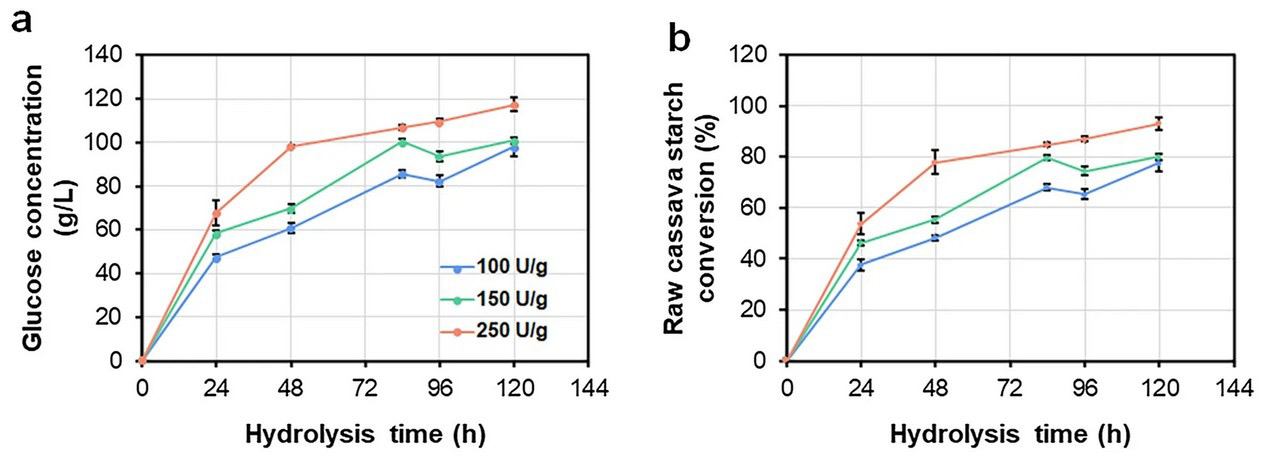
Figure 3. Saccharification of raw starch by engineered Penicillium oxalicum strain GXUR001. (a) Effect of GXUR001 RSDE loading on glucose released from hydrolysis of raw cassava flour. (b) Effect of GXUR001 RSDE loading on conversion of raw cassava flour. (Zhao et al. , 2022)
Your Reliable Mutagenesis Partner–What Our Clients Are Saying
"We used Creative BioMart’s GenePower™ Site-Directed Mutagenesis service to introduce three-point mutations into an antibody fragment targeting a novel cancer antigen. The accuracy was flawless, and we had fully sequence-verified plasmids back in just a few days. Their upstream support with template verification was a huge bonus."
— Senior Scientist | Biotech Startup (Protein Therapeutics Division)
"We were conducting a directed evolution experiment to enhance the thermal stability of a bacterial enzyme. Creative BioMart’s Controlled Randomization technology allowed us to focus mutations on just the catalytic domain—exactly what we needed. The mutational library was diverse, high quality, and arrived ahead of schedule. Their team even helped us optimize codon usage for downstream expression."
— Principal Investigator | University Molecular Biology Lab
"Our group needed an insertional mutagenesis approach to screen for unknown regulators in a KRAS-driven lung cancer model. The GenePower™ Insertional Mutagenesis service from Creative BioMart provided robust tools and support that dramatically accelerated our workflow. We identified two novel tumor suppressor candidates within weeks. Their technical team is incredibly responsive and helped us navigate each stage of the project."
— R&D Director | Pharmaceutical Company (Oncology Division)
"We had a complex project requiring simultaneous introduction of multiple mutations across a gene family involved in drought resistance. Creative BioMart delivered over 40 unique mutant constructs, all sequence-confirmed and expression-ready, within a ridiculously short timeframe. The scalability and consistency of their service impressed our whole department. Partnering with them saved us at least two months of in-house work."
— Head of Functional Genomics | Agricultural Biotech Firm
Frequently Asked Questions (FAQs) About Our Mutagenesis Services
-
Q: How fast can you deliver mutagenized constructs?
A: We pride ourselves on one of the shortest turnaround times in the industry. Thanks to our optimized protocols and proprietary GenePower™ technology, we can deliver fully sequence-verified plasmid DNA and bacterial clones within just a few days, depending on project complexity. -
Q: Do you guarantee the accuracy of mutations?
A: Absolutely. Every construct we deliver is 100% sequence-verified, and we guarantee that the intended mutations are correctly introduced—with no off-target changes. Accuracy is non-negotiable in our workflow. -
Q: Can you perform multiple mutations in a single project?
A: Yes! Our services support multiple simultaneous mutations—substitutions, insertions, deletions, or truncations—within a single gene or across gene families. There are no limits on mutation sites, making our platform ideal for high-throughput or combinatorial mutagenesis studies. -
Q: What types of mutagenesis do you offer?
A: We offer three core mutagenesis services through our GenePower™ platform:- Site-Directed Mutagenesis for precise single or multiple mutations
- Insertional Mutagenesis for forward genetic screens (e.g., cancer gene discovery)
- Controlled Random Mutagenesis for protein engineering or functional screening with tunable mutation rates and regions
-
Q: Do you offer support beyond mutagenesis itself?
A: Yes! We’re a one-stop solution. We offer template sequencing, expression vector construction, protein expression, and even protein purification. This lets you move seamlessly from gene design to functional analysis—all under one roof. -
Q: What kind of clients and projects do you typically support?
A: Our services are trusted by a wide range of clients—from academic labs doing fundamental gene function studies to pharmaceutical and biotech companies conducting therapeutic protein engineering or genome-wide mutagenesis screens. No project is too large—or too niche—for our team.
Resources
Related Services
References:
- Chen K, Zhang M, Ye M, Qiao X. Site-directed mutagenesis and substrate compatibility to reveal the structure–function relationships of plant oxidosqualene cyclases. Nat Prod Rep . 2021;38(12):2261-2275. doi:10.1039/D1NP00015B
- Vogne C, Beggah S, van der Meer J. Random and site-directed mutagenesis of transcriptional regulator proteins implicated in hydrocarbon degradation pathways. In: Handbook of Hydrocarbon and Lipid Microbiology . Springer, Berlin, Heidelberg; 2010:4429-4444. doi:10.1007/978-3-540-77587-4_346
- Zhao S, Tan MZ, Wang RX, et al . Combination of genetic engineering and random mutagenesis for improving production of raw-starch-degrading enzymes in Penicillium oxalicum . Microb Cell Fact . 2022; 21(1):272. doi:10.1186/s12934-022-01997-w
Contact us or send an email at for project quotations and more detailed information.
Quick Links
-

Papers’ PMID to Obtain Coupon
Submit Now -

Refer Friends & New Lab Start-up Promotions

